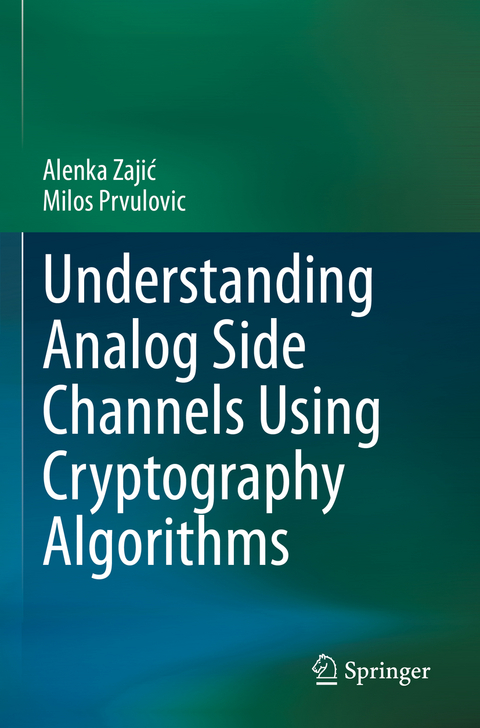
Understanding Analog Side Channels Using Cryptography Algorithms
Springer International Publishing (Verlag)
9783031385810 (ISBN)
This book offers the latest research results on analog side channels and their usage in cybersecurity. It demystifies analog side channels and demonstrates new use cases for them. The first part of this book discusses how analog side channels are generated, the physics behind it, the modeling and measurements of analog side channels, and their analogies to wireless communication systems. The second part of this book introduces new applications that benefit from leveraging side channels. In addition to breaking cryptography algorithms, it demonstrates how analog side channels can be used for malware detection, program profiling, hardware profiling, hardware/software attestation, hardware identification, and hardware Trojan detection.
Side channel is one of the methods for obtaining information about program execution. Traditionally, they are used in computer science to extract information about a key in cryptographic algorithms. What makes them different from other ways of extracting information about program execution is that side channels rely on how a system implements program execution, rather than what the program's algorithm specifies. Analog side channels are particularly powerful because they are not easy to suppress or detect that someone is collecting information from the system. Although they are very powerful tools, they are poorly understood.
This book targets advanced level students in computer science and electrical engineering as a textbook. Researchers and professionals working with analog side channels, how to model them, measure them, improve signal to noise ratio, and invent new signal processing techniques can also use this book. Computer scientists and engineers who want to learn new applications of side channels to improve system security, new techniques for breaking cryptography keys, new techniques for attestation, and new techniques for hardware Trojan detection will also want to purchase this book.
ALENKA ZAJIC (S'99-M'09-SM'13) received the B.Sc. and M.Sc. degrees from the School of Electrical Engineering, University of Belgrade, in 2001 and 2003, respectively, and the Ph.D. degree in electrical and computer engineering from the Georgia Institute of Technology in 2008. She is currently Ken Byers Professor with the School of Electrical and Computer Engineering, Georgia Institute of Technology. Prior to that, she was a Visiting Faculty Member at the School of Computer Science, Georgia Institute of Technology, a Postdoctoral Fellow at the Naval Research Laboratory, and a Design Engineer at Skyworks Solutions Inc. Her research interests span areas of electromagnetic, wireless communications, signal processing, and computer engineering. Dr. Zajic was a recipient of the following awards: The Best Student Paper Award at the 13th international IEEE conference on Hardware-Oriented Security and Trust (2020), IEEE Atlanta Section Outstanding Engineer Award (2019), The Best Poster Award atthe IEEE International Conference on RFID (2018), NSF CAREER Award (2017), Best Paper Award at the 49th Annual IEEE/ACM International Symposium on Microarchitecture (2016), the Best Student Paper Award at the IEEE International Conference on Communications and Electronics (2014), Neal Shepherd Memorial Best Propagation Paper Award (2012), the Best Paper Award at the International Conference on Telecommunications (2008), the Best Student Paper Award at the Wireless Communications and Networking Conference (2007), IEEE Outstanding Chapter Award as a Chair of the Atlanta Chapter of the AP/MTT Societies (2016), LexisNexis Dean's Excellence Award (2016), and Richard M. Bass/Eta Kappa Nu Outstanding Teacher Award (2016). She was an editor for IEEE Transactions on Wireless Communications 2012-2017 and an executive editor for Wiley Transactions on Emerging Telecommunications Technologies 2011-2016.
MILOS PRVULOVIC (S'97-M'03-SM'09) received the B.Sc. degree in electrical engineering from theUniversity of Belgrade in 1998, and the M.Sc. and Ph.D. degrees in computer science from the University of Illinois at Urbana-Champaign, in 2001 and 2003, respectively. He is currently a Professor with the School of Computer Science, Georgia Institute of Technology, where he joined in 2003. His research interests are in computer architecture, especially hardware support for software monitoring, debugging, and security. He was a past recipient of the NSF CAREER Award, and a Senior Member of the ACM and the IEEE Computer Society
Preface.- I Introduction.- Ii What Is An Analog Side Channel?.- Iii Analog Side Channels.- Iv Unintentionally Modulated Side Channels.- V Relationship Between Modulated Side Channels And Program Activity.- Vi Parameters That Affect Analog Side Channels.- Vii Modeling Analog Side Channels as Communication Systems.- Viii Using Analog Side-Channels For Malware Detection.- Ix Using Analog Side Channels For Program Profiling.- X Using Analog Side Channels For Hardware Event Profiling.- Xi Using Analog Side Channels for Hardware/Software Attestation.- Xii Using Analog Side Channels For Hardware Identification.- Xiii Using Analog Side Channels To Attack Cryptographic Implementations.- Xiv Using Analog Side Channels For Hardware Trojan Detection.
| Erscheinungsdatum | 04.10.2024 |
|---|---|
| Zusatzinfo | XVI, 467 p. 293 illus., 245 illus. in color. |
| Verlagsort | Cham |
| Sprache | englisch |
| Maße | 155 x 235 mm |
| Themenwelt | Informatik ► Theorie / Studium ► Kryptologie |
| Schlagworte | analog-side channels • Cryptography algorithms • cybersecurity • hardware and software attestation • hardware identification • hardware profiling • hardware Trojan detection • malware detection • measurements of analog side channels • modeling of analog side channels • Side-channels • software profiling |
| ISBN-13 | 9783031385810 / 9783031385810 |
| Zustand | Neuware |
| Informationen gemäß Produktsicherheitsverordnung (GPSR) | |
| Haben Sie eine Frage zum Produkt? |
aus dem Bereich


